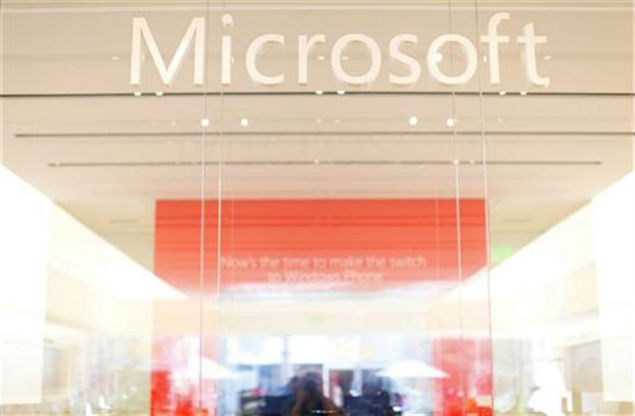- Home
- Laptops
- Laptops News
- Microsoft sends engineers to schools to encourage next generation
Microsoft sends engineers to schools to encourage next generation

"My teacher said there's a lot of money to be made in computer science," Leandre said. "It could be really helpful in the future."
That teacher, Steven Edouard, knows a few things about the subject. When he is not volunteering as a computer science instructor four days a week, Mr. Edouard works at Microsoft. He is one of 110 engineers from high-tech companies who are part of a Microsoft program aimed at getting high school students hooked on computer science, so they go on to pursue careers in the field.
In doing so, Microsoft is taking an unusual approach to tackling a shortage of computer science graduates one of the most serious issues facing the technology industry, and a broader challenge for the nation's economy.
There are likely to be 150,000 computing jobs opening up each year through 2020, according to an analysis of federal forecasts by the Association for Computing Machinery, a professional society for computing researchers. But despite the hoopla around start-up celebrities like Mark Zuckerberg of Facebook, fewer than 14,000 American students received undergraduate degrees in computer science last year, the Computing Research Association estimates. And the wider job market remains weak.
"People can't get jobs, and we have jobs that can't be filled," Brad Smith, Microsoft's general counsel who oversees its philanthropic efforts, said in a recent interview.
Big technology companies have complained for years about a dearth of technical talent, a problem they have tried to solve by lobbying for looser immigration rules to accommodate more foreign engineers and sponsoring tech competitions to encourage student interest in the industry. Google, for one, holds a programming summer camp for incoming ninth graders and underwrites an effort called CS4HS, in which high school teachers sharpen their computer science skills in workshops at local universities.
But Microsoft is sending its employees to the front lines, encouraging them to commit to teaching a high school computer science class for a full school year. Its engineers, who earn a small stipend for their classroom time, are in at least two hour long classes a week and sometimes as many as five. Schools arrange the classes for first thing in the day to avoid interfering with the schedules of the engineers, who often do not arrive at Microsoft until the late morning.
The program started as a grass-roots effort by Kevin Wang, a Microsoft engineer with a master's degree in education from Harvard.
In 2009, he began volunteering as a computer science teacher at a Seattle public high school on his way to work. After executives at Microsoft caught wind of what he was doing, they put financial support behind the effort which is known as Technology Education and Literacy in Schools, or Teals and let Mr. Wang run it full time.
The program is now in 22 schools in the Seattle area and has expanded to more than a dozen other schools in Washington, Utah, North Dakota, California and other states this academic year. Microsoft wants other big technology companies to back the effort so it can broaden the number of outside engineers involved.
This year, only 19 of the 110 teachers in the program are not Microsoft employees. In some cases, the program has thrown together volunteers from companies that spend a lot of their time beating each other up in the marketplace.
"I think education and bringing more people into the field is something all technology companies agree on," said Alyssa Caulley, a Google software engineer, who, along with a Microsoft volunteer, is teaching a computer science class at Woodside High School in Woodside, Calif.
While computer science can be an intimidating subject, Microsoft has sought to connect it to the technologies most students use in their everyday lives. At Rainier Beach High recently, Peli de Halleux, a Microsoft software engineer, taught a class on making software for mobile phones.
The students buried their faces in the phones, supplied by Microsoft. They were asked to create programs that performed simple functions, like playing a random song when the phones were shaken.
Copyright 2012 The New York Times News Service
Get your daily dose of tech news, reviews, and insights, in under 80 characters on Gadgets 360 Turbo. Connect with fellow tech lovers on our Forum. Follow us on X, Facebook, WhatsApp, Threads and Google News for instant updates. Catch all the action on our YouTube channel.
- Samsung Galaxy Unpacked 2025
- ChatGPT
- Redmi Note 14 Pro+
- iPhone 16
- Apple Vision Pro
- Oneplus 12
- OnePlus Nord CE 3 Lite 5G
- iPhone 13
- Xiaomi 14 Pro
- Oppo Find N3
- Tecno Spark Go (2023)
- Realme V30
- Best Phones Under 25000
- Samsung Galaxy S24 Series
- Cryptocurrency
- iQoo 12
- Samsung Galaxy S24 Ultra
- Giottus
- Samsung Galaxy Z Flip 5
- Apple 'Scary Fast'
- Housefull 5
- GoPro Hero 12 Black Review
- Invincible Season 2
- JioGlass
- HD Ready TV
- Laptop Under 50000
- Smartwatch Under 10000
- Latest Mobile Phones
- Compare Phones
- Redmi Note 15 5G
- Redmi Note 15 Pro 5G
- Redmi Note 15 Pro+ 5G
- Lava Play Max
- Poco C85 5G
- Honor Magic 8 Lite
- Jolla Phone
- Realme P4x 5G
- Asus ProArt P16
- MacBook Pro 14-inch (M5, 2025)
- OnePlus Pad Go 2
- Poco Pad M1
- Just Corseca Skywatch Pro
- Honor Watch X5
- Acerpure Nitro Z Series 100-inch QLED TV
- Samsung 43 Inch LED Ultra HD (4K) Smart TV (UA43UE81AFULXL)
- Asus ROG Ally
- Nintendo Switch Lite
- Haier 1.6 Ton 5 Star Inverter Split AC (HSU19G-MZAID5BN-INV)
- Haier 1.6 Ton 5 Star Inverter Split AC (HSU19G-MZAIM5BN-INV)












